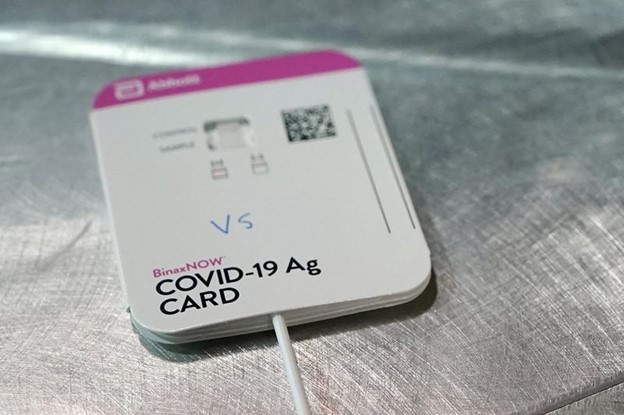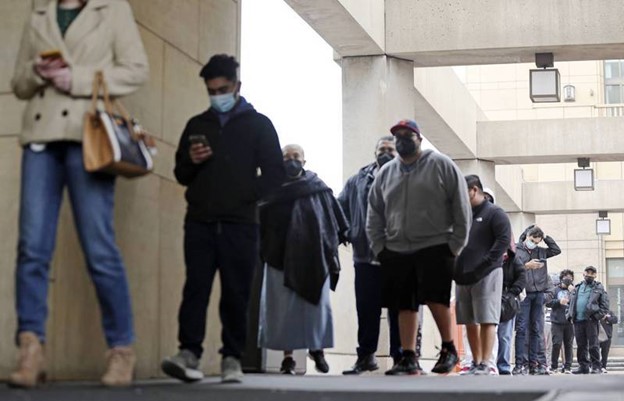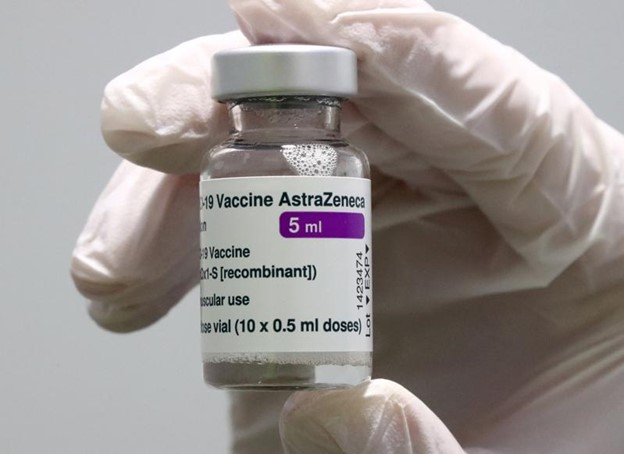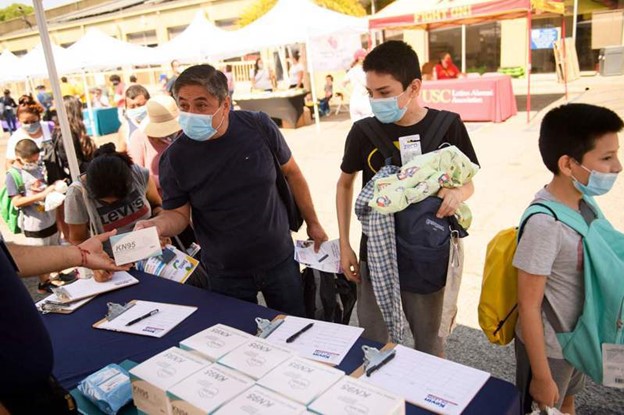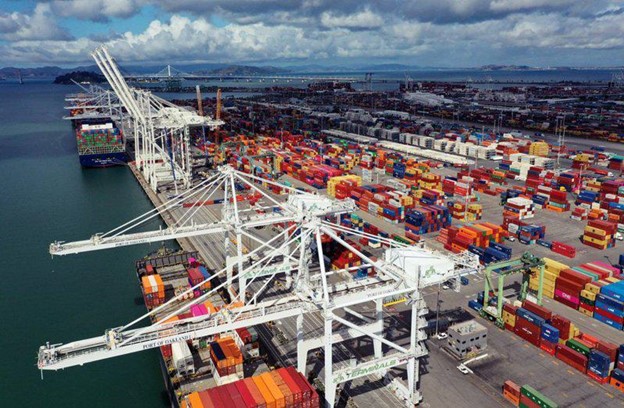U.S. residents can pre-order a free COVID-19 home quick test kit starting Jan. 19. (Associated Press)
(We Chinese in America Media Editor Tang Zhao, January 15, 2022) The Biden administration announced on the 14th that starting Wednesday, January 19, U.S. residents can pre-order “Free at-home COVID-19 tests.” Each household can place an order on the official website (COVIDTests.gov) to receive up to four sets of rapid screening kits. Government agencies will also set up a set of phone numbers to serve those without internet access. The White House noted that at-home screening kits ordered generally arrive within 7 to 12 days. This also means that if people place an order on the 19th, they will have to wait until the end of January at the earliest to get the quick screening test kits.
People who book a free home quick-screening test kit must provide their name and email address when placing the order, and then they can track the quick-screening test kit order through the email mailbox. The U.S. Digital Service, which operates the program, says it's ready. In order to facilitate smooth transportation, the United States Postal Service (USPS) is also preparing to deliver rapid screening test kits and plans to hire 7,000 temporary workers to assist in the implementation of the plan. As of January 14, the Biden administration has purchased 1 billion home rapid screening kits and provided them to American residents for free. The White House also plans to start providing high-quality free masks in the next few weeks. The White House also promised on the 12th that it will provide 5 million sets of new coronavirus rapid screening and nucleic acid (PCR) testing kits to K-12 schools nationwide for free each month to ensure the safety of school opening and face-to-face teaching.
(Source: Compiled from Online Information)
The increase in Omicron cases in many parts of the United States seems to be slowing down, and the number of people going to the emergency room has dropped significantly. The picture shows Los Angeles citizens queuing for testing. (Getty Images)
(We Chinese in America Media Editor Tang Zhao, January 14, 2022) Public health officials and infectious disease experts say the Omicron outbreak from Mid-Atlantic to New England is beginning to show signs of slowing; they are cautious but optimistic that a turnaround may be expected, and the U.S. Omicron outbreak may be like the U.K., which has seen a slowdown and other countries.
A variant of the Omicron virus has pushed U.S. cases and hospitalizations to new highs, but public health officials and experts this week began to see early signs that the outbreak is nearing a peak or stabilizing in parts of the Northeast.
Newly confirmed cases in New York City increased by more than 20 times in December but have leveled off in the past few days; New Jersey and Maryland also saw a slight decline in new confirmed cases this week, as the epidemic data in many large cities. New York Governor Kathy Hochul said this week: "It looks like we may be crossing the peak of the epidemic."
"Sudden drop in the amount of coronavirus detected in wastewater"
"We try not to predict the development of the new coronavirus, because it always surprises us," said Shira Doron, an epidemiologist at Tufts Medical Center in Boston, "but at least the amount of the new coronavirus was detected in the wastewater has plummeted, and we hope that means cases will plummet, and hospitalizations and deaths will follow."
Previous new coronavirus variants tended to have a longer cycle of high and low peaks, usually after an outbreak, cases continued to climb for about two months before declining; Omicron has high transmissibility and can spread faster, which means it will be infected high-risk groups more quickly.
Experts warn: the state of emergency is not over yet
Many experts believe Omicron cases will decline as fast as it climbs.
The current state of emergency is not over, though, and Omicron cases are only nearing a peak in the places where the outbreak first started, mainly in the Northeastern states, while cases in other states are still climbing.
According to statistics from Johns Hopkins University, nearly 895,000 new cases of new coronary pneumonia and more than 2,400 people died in the United States on the 12th; the average daily new diagnosis in the past week exceeded 786,000 cases. That’s a 159% increase from the daily average two weeks ago. More than 151,000 people in the U.S. are currently hospitalized with the virus.
Confirmation rates in seven states, including New York, New Jersey, Maryland, Ohio, Georgia, Kansas, and Mississippi, began to flatten; Washington saw a 19 percent drop in new cases last week.
UK appears to have crossed the Omicron peak
The UK appears to have crossed the peak of the outbreak caused by Omicron, showing that Omicron is highly transmissible but short-lived, which may be good news that the epidemic is fading. Scientists say the U.K. outbreak data is good news for the U.S. and other countries, suggesting that Omicron is expected to replicate the South African model, where cases spiked for about a month before plummeting.
(Source: Compiled from Online Information)
A British pharmaceutical company AstraZeneca said today that preliminary data from a trial showed that the AZ vaccine, as an anti-epidemic booster, produced a large antibody response to Omicron and mutant viruses such as Beta, Delta, Alpha and Gamma.
(We Chinese in America Media Editor Tang Zhao, January 13, 2022) AstraZeneca said that regardless of previous vaccination with the AZ vaccine (Vaxzevria) or the messenger RNA (mRNA) vaccine, an increased immune response was seen after the third dose of the AZ vaccine. AstraZeneca said they will send the data to national drug regulators against Omicron
AstraZeneca's vaccine was co-developed with Oxford University researchers, and laboratory studies last month found that three doses of the AZ vaccine were effective against the Omicron mutated virus.
Andrew Pollard, director of the Oxford Vaccine Group, said in a statement: "These important studies show that, regardless of whether the two previous doses of the vaccine were AZ or mRNA or even inactivated vaccine, only a third dose of AZ vaccine is required., can significantly enhance immunity to COVID-19.”
A large-scale trial in the United Kingdom in December last year found that after the AZ vaccine or the Pfizer/BNT (Pfizer-BioNTech) vaccine, the third dose of the AZ vaccine could increase antibodies; but it also concluded that with BNT and Moderna, using two mRNA vaccines as supplements, the antibody increase will be the largest.
(Source: Central News Agency)
President Biden announced on the 13th that the federal government will double the distribution of 1 billion free home Omicron testing kits and N95 or KN95 masks. The picture shows the YMCA in Los Angeles giving out free KN95 masks. (Getty Images)
(We Chinese in America Media Editor Tang Zhao, January 14, 2022) President Biden announced on the 13th that the federal government will launch a website for people to register for Omicron test kits next week, double the distribution of 1 billion free home new crown test kits and N95 masks, and dispatch 1,000 military doctors to relieve the pressure on hospitals. He also called on the media to curb misinformation about the outbreak and vaccines.
The first batch of test kits will be distributed next week
On the other hand, Senator Bernie Sanders (Vermont) and 50 Democratic members of Congress have proposed a bill on the 12th that requires the federal government to issue N95 masks to every American.
The Omicron variant virus has led to a sharp increase in cases. Biden said he has asked the government team to double the purchase of Omicron test kits, expanding from the original order of 500 million boxes to 1 billion boxes; the first batch of test kits will be distributed next week, when the federal government website will also be launched for Americans to register for free test kits, while additional test kits will be distributed in the coming months.
1,000 Military doctors were dispatched to the hardest-hit areas
Biden also announced at the White House that starting next week, 1,000 military medical personnel will be dispatched to many cities across the country to alleviate the shortage of medical personnel caused by the epidemic; Biden pointed out that the newly dispatched military medical team will be deployed in the hardest-hit areas. Michigan, New Jersey, New Mexico, New York, Ohio, and Rhode Island.
"High-quality" N95 masks will also be distributed
Biden also announced for the first time that the government plans to produce and distribute "high-quality" N95 masks, which are currently the most effective masks for epidemic prevention. Further details will be announced next week. The White House said earlier this week that the federal government has more than 750,000 N95 masks.
Biden admitted frankly that the United States entered the new year but saw a record high number of cases. He knew that everyone was frustrated, but he emphasized that this was a "pandemic of the unvaccinated"; although it is possible to contract the virus whether it is vaccinated against the new crown, Biden cited medical figures showing that the probability of severe illness and death after vaccination will be much lower. "Whether or not vaccinated will lead to very different consequences."
Biden calls on the media to curb fake news about the epidemic.
Biden finally called on the media to curb false information about the epidemic. "I would like to specifically ask social media companies and the media to deal with the wrong and false news on your platforms. This must stop."
Sanders proposed the "Masks for All Act" draft in 2020, requiring the federal government to issue a box of N95 masks to every American. On the 12th, he raised the case with 50 Democrats. Senate Majority Leader Chuck Schumer and White House Epidemic Prevention Coordinator Jeff Zients said the Biden administration is now actively seeking ways to make it easier for the public to obtain N95 masks.
Sanders pointed out that the federal government should provide free high-quality N95 masks to all people to avoid death and suffering and save the medical system considerable costs.
(Source: Compiled from Online Information)
The latest consumer price index released by the U.S. Department of Labor on the 12th is the inflation report for December 2021. Compared with the same period in 2020 the previous year, the average domestic inflation in the United States came to 7%. (Getty Images)
(We Chinese in America Media Editor Tang Zhao, January 13, 2022)"Prices have been rising, how does Biden put out the fire?" The U.S. Department of Labor released the latest National Consumer Price Index (CPI) on the 12th, showing that the overall inflation rate in the United States has reached 7% in December 2021. The speed at which everything is rising has reached a "40-year high" since June 1982 - although the Biden administration and the Fed have previously believed that the current inflation problem is only a "short-term response to the post-pandemic", as long as the global supply chain continues to stabilize, and in line with the pace of resumption of work and employment and economic recovery in the United States, the United States will be able to control this wave of "epidemic inflation" by slowly raising interest rates starting in mid-2022. However, the latest CPI report shows that prices continue to rise, which seems to be more durable than Biden's imagination. Therefore, market opinion also judges that the Fed will move ahead and raise interest rates in March ahead of schedule.
But while U.S. inflation hit a 40-year high, what happened in June 1982, when the last record happened? Why is soaring U.S. inflation more difficult to suppress than Washington thinks? Why did Biden fail to act, and what are his political and economic concerns? The latest consumer price index released by the U.S. Department of Labor on the 12th is the inflation report for December 2021. Compared with the same period in 2020 the previous year, the average domestic inflation in the United States came to 7%. Among them, the "Core Price Index", which integrates food prices, fuel prices... The number is a little slower, but it is the largest increase since 1991.
The report shows that in addition to the core price index, the two major price items that reflected the U.S. inflation trend in December last year were “rent” and “used car prices.” In terms of rent, the average rent in the United States has risen in the past year. The price of used cars has soared due to the "lack of cars" and "increase in new car prices" caused by the global chip shortage and supply chain disruption. It rose another 3.5% in November.
The Wall Street Journal said that the CPI report in December 2021 confirmed that the high inflation trend in the United States is more difficult than imagined. Although in terms of core price indices such as energy and food prices, the "inflation speed" in December was slightly slower than that in November, and the soaring angle of inflation also slowed down. But the inflation rate of 7% is still a "40-year high" since 7.1% in June 1982.
However, the current inflation situation in the United States is very different from that in 1982. At present, the current inflation situation in the United States is triggered by the epidemic, and it is still in the "rising stage" until now. But in the state of 1982, the U.S. economy was heading towards the "high inflation end point".
The "Financial Times" emphasized that a reasonable and moderate inflation rate is a positive indicator for the US economy, which means that demand is growing, and the market has investment incentives. Although the current CPI figure in the United States is a 40-year high since 1981, the rate of inflation has slowed down from November to December. Compared with the double-digit inflation from 1979 to 1981, thus. economy is far from a crisis at all.
But the problem is that the current wave of price inflation has begun to make the public feel pain -Especially for the middle- and lower-class income earners, their disposable daily expenses are more likely to be overwhelmed by the rising housing prices, rent and food, and daily necessities prices. At a time when the domestic epidemic in the United States is entering its "final peak", this may cause an unimaginable social crisis.
Generally speaking, the way to fight inflation is for the Fed to "raise interest rates" to cool the market. After years of quantitative easing and ultra-low interest rate policies, the Federal Reserve has repeatedly warned as early as last year that the United States will begin to "normalize monetary policy" in 2022 and gradually raise interest rates during the year.
However, as the epidemic disrupted the global market supply chain, the local epidemic situation in the United States from last winter to the present has been fluctuating due to the emergence of Omicron. For this reason, in the past few months, the US federal government has hoped to use this wave of "post-epidemic inflation" to accelerate the recovery of the market economy, and on the other hand, it also hopes to use this to promote the original "post-epidemic resignation wave". The number of American workers will also be forced to return to the job market more actively because of inflation and price pressures, so as to effectively distribute the labor force and alleviate the current "big job shortage" dilemma.
Therefore, despite the nervousness that the inflation figures have been rising for consecutive months, the executives of the administration headed by Biden still believe that this is only a "short-term effect", and there is no need to tighten the monetary policy that would have raised interest rates earlier. ecause ause according to the existing trends and figures, the domestic inflation figures in the United States still show no signs of "effective relief", and the labor ebb tide and labor shortage problems have reversed because of the outbreak of Omicron in the United States. The problem of the global supply chain is also stuck on the verge of the limit of the epidemic in China and its "zero countermeasures", and the end cannot be seen for a while. Instead, it may encounter more severe short-term supply chain disruptions after the Lunar New Year and the Beijing Winter Olympics. Therefore, after the December CPI figures came out, the Federal Reserve, which had repeatedly released rumors to "raise interest rates earlier", also strengthened the market's suggestion of raising interest rates earlier in March.
"The problem of the supply chain should be resolved soon within this year... I am more worried about the return to work of the local labor force, which may be more serious and difficult than the supply chain shock." In a statement to the House of Representatives on the 11th, Fed Chairman Jerome Powell said.
The "Wall Street Journal" pointed out that due to the long holiday at the end of the year and the outbreak of the Omicron epidemic in the United States in December, the employment situation, and the morale of the resumption of work in the market are not obvious, and there is even a delay and wait-and-see situation, especially in hotels, tourism, and catering. Service providers are currently forced to sharply increase their service prices due to severe labor shortages and rising prices of everything. If the situation persists beyond the spring, it may bring another wave of operating pressure to collective closures of small and medium-sized U.S. companies.
Considering that the United States is about to usher in the "midterm elections" in November this year, electoral movements in various places and the next generation of political views in the Congress and opposition will begin to compete fiercely after the spring. If Biden is unable to effectively revive inflation, employment and people's livelihood and economic issues, "the people can feel" the post-epidemic recovery results, for the ruling Democratic Party, it will inevitably bring about a domino effect of doubts about Biden's re-election.
(Source: Compiled from Online Information)




